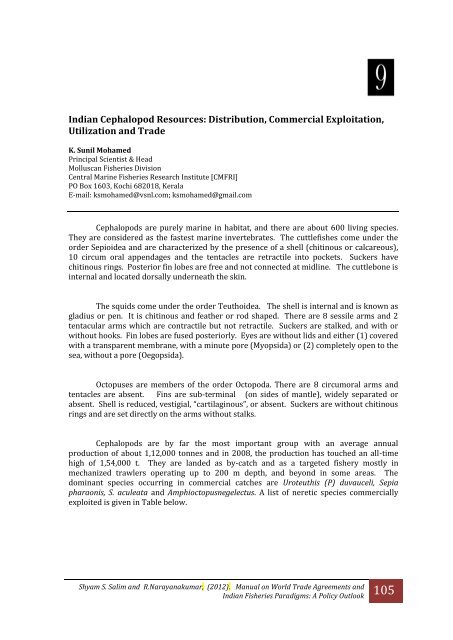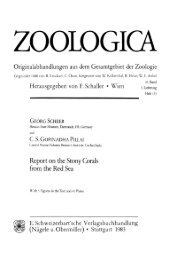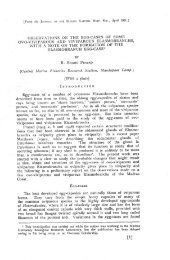K. Sunil Mohamed - Eprints@CMFRI - Central Marine Fisheries ...
K. Sunil Mohamed - Eprints@CMFRI - Central Marine Fisheries ...
K. Sunil Mohamed - Eprints@CMFRI - Central Marine Fisheries ...
Create successful ePaper yourself
Turn your PDF publications into a flip-book with our unique Google optimized e-Paper software.
Indian Cephalopod Resources: Distribution, Commercial Exploitation,<br />
Utilization and Trade<br />
K. <strong>Sunil</strong> <strong>Mohamed</strong><br />
Principal Scientist & Head<br />
Molluscan <strong>Fisheries</strong> Division<br />
<strong>Central</strong> <strong>Marine</strong> <strong>Fisheries</strong> Research Institute [CMFRI]<br />
PO Box 1603, Kochi 682018, Kerala<br />
E-mail: ksmohamed@vsnl.com; ksmohamed@gmail.com<br />
Cephalopods are purely marine in habitat, and there are about 600 living species.<br />
They are considered as the fastest marine invertebrates. The cuttlefishes come under the<br />
order Sepioidea and are characterized by the presence of a shell (chitinous or calcareous),<br />
10 circum oral appendages and the tentacles are retractile into pockets. Suckers have<br />
chitinous rings. Posterior fin lobes are free and not connected at midline. The cuttlebone is<br />
internal and located dorsally underneath the skin.<br />
The squids come under the order Teuthoidea. The shell is internal and is known as<br />
gladius or pen. It is chitinous and feather or rod shaped. There are 8 sessile arms and 2<br />
tentacular arms which are contractile but not retractile. Suckers are stalked, and with or<br />
without hooks. Fin lobes are fused posteriorly. Eyes are without lids and either (1) covered<br />
with a transparent membrane, with a minute pore (Myopsida) or (2) completely open to the<br />
sea, without a pore (Oegopsida).<br />
Octopuses are members of the order Octopoda. There are 8 circumoral arms and<br />
tentacles are absent. Fins are sub-terminal (on sides of mantle), widely separated or<br />
absent. Shell is reduced, vestigial, “cartilaginous”, or absent. Suckers are without chitinous<br />
rings and are set directly on the arms without stalks.<br />
Cephalopods are by far the most important group with an average annual<br />
production of about 1,12,000 tonnes and in 2008, the production has touched an all-time<br />
high of 1,54,000 t. They are landed as by-catch and as a targeted fishery mostly in<br />
mechanized trawlers operating up to 200 m depth, and beyond in some areas. The<br />
dominant species occurring in commercial catches are Uroteuthis (P) duvauceli, Sepia<br />
pharaonis, S. aculeata and Amphioctopusnegelectus. A list of neretic species commercially<br />
exploited is given in Table below.<br />
Shyam S. Salim and R.Narayanakumar, (2012). Manual on World Trade Agreements and<br />
Indian <strong>Fisheries</strong> Paradigms: A Policy Outlook 105
K. <strong>Sunil</strong> <strong>Mohamed</strong><br />
106<br />
Table 9.1 List of commercially exploited cephalopods from Indian Seas<br />
Species<br />
Squids<br />
Common Name Distribution<br />
Uroteuthis (Photolologo)<br />
duvauceli<br />
Indian squid All along Indian coast<br />
Loliolus (Nipponlologo)<br />
uyii<br />
Little squid Madras & Visakhapatnam<br />
U. (P) edulis Needle squid SW and SW coast<br />
Loliolus (Loliolus)<br />
hardwickei<br />
Investigator squid All along Indian coast<br />
Sepioteuthislessoniana Palkbay squid Palk bay & Gulf of Mannar<br />
Sthenoteuthisoualaniensis Oceanic squid Oceanic Indian EEZ<br />
Thysanoteuthis rhombus<br />
Cuttlefishes<br />
Diamond squid Oceanic Indian EEZ<br />
Sepia pharaonis Pharaoh cuttlefish All along Indian coast<br />
S. aculeata Needle cuttlefish All along Indian coast<br />
S. elliptica Golden cuttlefish Veraval & Cochin<br />
S. prashadi Hooded cuttlefish SW & SE coast<br />
S. brevimana Shortclub cuttlefish Madras & Visakhapatnam<br />
Sepiellainermis<br />
Octopuses<br />
Spineless cuttlefish All along Indian coast<br />
Amphioctopusneglectus Webfoot octopus SW & SE coast and islands<br />
A. marginatus Veined Octopus SW & SE coast and islands<br />
A. aegina Marbled octopus SW & SE coast and islands<br />
Octopus vulgaris Common octopus SW & SE coast and islands<br />
Cistopusindicus Old woman octopus SW & SE coast and islands<br />
Methods of Exploitation<br />
Although about 40 per cent of the world's cephalopod catches are taken by squid<br />
jigging and 25 per cent by trawling, in India, cephalopods are principally caught by bottom<br />
trawlers operating upto 200m depth zones. While most of the catch is brought in as bycatch<br />
from the shrimp and fish trawls employed by the trawlers, of late, there is a targeted<br />
fishery for cuttlefishes during the post monsoon period (Sep-Dec) using off bottom high<br />
opening trawls along the SW and NW coast. Prior to the seventies traditional gears like<br />
shore seines, boat seines, hooks and lines and spearing were the principal gear employed to<br />
capture cephalopods. These traditional gears continue to be used especially for cuttlefishes<br />
at Vizhinjam, where there is no trawl fishery. Experimental squid jigging has been tried with<br />
Japanese expertise along the west coast by GOI vessels with considerable success (Nair et al.,<br />
1992a). However, commercial squid jigging is not practised in India.<br />
Cephalopod Production<br />
Cephalopod production, which remained at very low level upto the early seventies,<br />
has shown a remarkable increase crossing the 100,000 tonne mark in 1994. From 1973<br />
onwards the commencement of export of frozen cephalopod products to several countries<br />
saw the transition of the resource from a discard to a quality resource fetching high foreign<br />
exchange (Silas, 1985). Thereafter its production showed a steep increase. The west coast<br />
<strong>Central</strong> <strong>Marine</strong> <strong>Fisheries</strong> Research Institute,<br />
Kochi : Cadalmin, 458 pp.
Indian Cephalopod Resources: Distribution, Commercial Exploitation, Utilization and Trade<br />
maritime states, Gujarat (GUJ), Maharashtra (MAH), Goa (GOA), Karnataka (KAR) and Kerala<br />
(KER) contribute to the bulk (86 per cent) of the production. While the production from the<br />
east coast amounts to only 14 per cent, of which, Tamil Nadu (TN) contributes the maximum<br />
followed by Andhra Pradesh (AP). The states of West Bengal (WB), Orissa (OR) and<br />
Pondicherry (PON) contribute only a small percentage. Overall, KER ranks first contributing<br />
a third of the all India production followed by MAH, GUJ and KAR. The cephalopod<br />
production (t.km -2) in different maritime states indirectly this indicates the relative<br />
abundance in the continental shelf and level of exploitation of cephalopods in the different<br />
maritime states. Maximum productivity (0.699 t/km 2) was observed in Kerala, followed by<br />
Tamil Nadu, Karnataka, Maharashtra and Goa.<br />
At the national level, Jan-Mar and Oct-Dec were the most productive period. Along<br />
the upper east and west coast, the above months were the most productive, while in KAR,<br />
KER, TN and AP Jul-Sep was also equally productive.<br />
Species-wise Production<br />
The neretic squid U. duvauceli followed by the pharaoh cuttlefish S. pharaonis and<br />
the needle cuttlefish S. aculeata together contribute to 84 per cent of the total cephalopod<br />
production from India. Along the west coast, U. duvauceli contributes to more than 50 per<br />
cent of the landings, followed closely by S. pharaonis and S. aculeata (47 per cent). Among<br />
squids, U. edulis and among cuttlefishes, S. elliptica form significant part of the catch from<br />
Kerala and Gujarat respectively. A number of octopus species, chiefly, A. neglectus forms 5-6<br />
per cent of the catch mainly from Kerala.<br />
The dominant species in landings from the east coast is S. pharaonis, followed by U.<br />
duvauceli and S. aculeata. The diversity of squid and cuttlefish species exploited in<br />
commercial quantities is more along east coast as compared to west coast. U. edulis and S.<br />
lessoniana are also caught in considerable quantities from TN and AP. Octopus species,<br />
which were formerly discarded, has gained importance in recent years. The major<br />
production is from Kerala State. Their proportions in the landings from both the coasts are<br />
increasing considering the export value of the same.<br />
Utilization and Marketing<br />
About 15-20 per cent (Rs 1,393 Crores) of our marine products export earnings (Rs.<br />
8,608 Cr.) is from cephalopods, comprising of coastal squids, cuttlefishes and octopuses in<br />
2008-09. The squid export from India increased from 34,172 tons in 2007-08 to 57,125 tons<br />
in 2008-09 registering an increase of 67 per cent. Existing destination markets for the<br />
currently exploited squids from India are in EU, US, Japan and Mediterranean countries such<br />
as Spain, Greece, Italy and Portugal.<br />
The squids products presently exported from India are presented in the below<br />
figure. Among the 44 varieties, the frozen (Fr.) squid (SQ.) whole (W.) and frozen squid<br />
whole cleaned (W.C.) contributed more than 60 per cent to the exports.<br />
In spite of upsurge in the demand for ready-to-eat and ready-to-cook products in<br />
international and domestic markets, our export of value-added squid product such as frozen<br />
squid rings breaded (Fr. SQ. Rings (breaded)) and frozen squid stuffed is less than 1 per<br />
cent.<br />
Shyam S. Salim and R.Narayanakumar, (2012). Manual on World Trade Agreements and<br />
Indian <strong>Fisheries</strong> Paradigms: A Policy Outlook 107
K. <strong>Sunil</strong> <strong>Mohamed</strong><br />
108<br />
Table 9.2 Unit value realized for squid products exported from India<br />
ITEM Product Form Grade Price (US<br />
$)<br />
Market Origin<br />
Fillet 2/4 8.90<br />
5/7 8.50<br />
8/12<br />
13/20<br />
6.60<br />
5.90<br />
JAPAN Tuticorin<br />
Wings U/10 1.85<br />
10/20<br />
20/up<br />
1.85<br />
1.85<br />
JAPAN Tuticorin<br />
Whole, cleaned 10/20 2.20 USA Kollam<br />
20/40 1.65<br />
Whole 3/6 1.85 (Euro)<br />
Coasta<br />
l<br />
Squid<br />
Whole Cleaned<br />
6/10<br />
10/20<br />
6/10<br />
10/20<br />
20/40<br />
1.70 (Euro)<br />
1.35 (Euro)<br />
3.00<br />
2.60<br />
2.50<br />
SPAIN<br />
EU<br />
Kollam<br />
Veraval<br />
WC Tray pack 20/40 2.65 ITALY Mumbai<br />
Rings blanched IQF 40/60 2.50 ITALY Kochi<br />
60/up 2.80<br />
Tentacles blanched<br />
IQF<br />
60/up 2.15 ITALY Kochi<br />
Rings blanched IQF 60/up 2.30 FRANCE Kochi<br />
Tentacles blanched 60/up 2.20 FRANCE Kochi<br />
IQF<br />
Broken 1.80<br />
Whole 10/20 1.95<br />
20/40<br />
40/60<br />
1.35<br />
0.90<br />
UAE<br />
Mangalore<br />
Export Quantity (t)<br />
40000<br />
30000<br />
20000<br />
10000<br />
Fig 9.1 Quantity of neretic squid exported to different international destinations from India<br />
<strong>Central</strong> <strong>Marine</strong> <strong>Fisheries</strong> Research Institute,<br />
Kochi : Cadalmin, 458 pp.<br />
0<br />
1999-00<br />
2001-02<br />
2003-04<br />
2005-06<br />
2007-08<br />
JAPAN<br />
SE ASIA<br />
OTHERS<br />
M IDDLE EAST<br />
CHINA<br />
USA<br />
EU
Indian Cephalopod Resources: Distribution, Commercial Exploitation, Utilization and Trade<br />
WHOLE NEEDLE<br />
SQUID SALAD<br />
IQF SLICED<br />
IQF TUBES (STUF)<br />
CLEANED TRAY PACK<br />
WHOLE COOKED<br />
RINGS (BREADED)<br />
IQF TUBES (BLAN)<br />
RINGS (BOILED)<br />
IQF TUBES<br />
IQF WHOLE<br />
WHOLE (BABY SQ)<br />
TUBE (PINK)<br />
TUBE (WHITE)<br />
IQF RINGS (BLAN)<br />
IQF TENTA (BLAN)<br />
IQF MIX (BLAN)<br />
TUBE BLAN<br />
IQF WINGS<br />
IQF STRIPS<br />
THROAT MEAT<br />
TENTACLES BLAN<br />
BABY SQUID<br />
WHOLE ROUND<br />
IQF CLEANED<br />
IQF STUFFED<br />
IQF PEELED<br />
IQF FILLETS<br />
IQF TENTACLES<br />
IQF RINGS<br />
STRIPS<br />
TIPS/CONES<br />
RINGS BLAN.<br />
BLANCHED<br />
TRAY PACK<br />
WINGS<br />
MISC.<br />
WHOLE STUFFED<br />
WHOLE PEELED<br />
FILLETS<br />
TENTACLES<br />
RINGS<br />
TUBE<br />
WHOLE CLEANED<br />
WHOLE<br />
0 5000 10000 15000 20000 25000 30000<br />
Figure 9.2. Coastal Squid products exported from India<br />
Export value (INR Crore)<br />
400<br />
300<br />
200<br />
100<br />
0<br />
1999-00<br />
2001-02<br />
2003-04<br />
2005-06<br />
2007-08<br />
CHINA<br />
SE ASIA<br />
OTHERS<br />
M IDDLE EAST<br />
Quantity (t)<br />
Figure 9.3 Export value realized from neretic squid exports<br />
Shyam S. Salim and R.Narayanakumar, (2012). Manual on World Trade Agreements and<br />
Indian <strong>Fisheries</strong> Paradigms: A Policy Outlook 109<br />
JAPAN<br />
USA<br />
EU
K. <strong>Sunil</strong> <strong>Mohamed</strong><br />
Oceanic Squids<br />
The purpleback flying squid Sthenoteuthis oualaniensis (Lesson, 1830) is distributed<br />
in the tropical and sub-tropical areas of the Pacific and Indian Oceans. The Arabian Sea is<br />
considered as one of the richest regions for these oceanic squids in the Indian Ocean. These<br />
squids are pelagic animals living in the open ocean, usually absent over the continental<br />
shelves (
















